Services Marketing and Relationship Marketing: SYDNEY HOTEL
VerifiedAdded on 2023/06/04
|6
|2212
|210
AI Summary
This essay explores the flowcharts of the front-stage and back-stage functions and operations of the service organization Sydney Hotel and service encounter significance. It also analyzes the managerial implications.
Contribute Materials
Your contribution can guide someone’s learning journey. Share your
documents today.
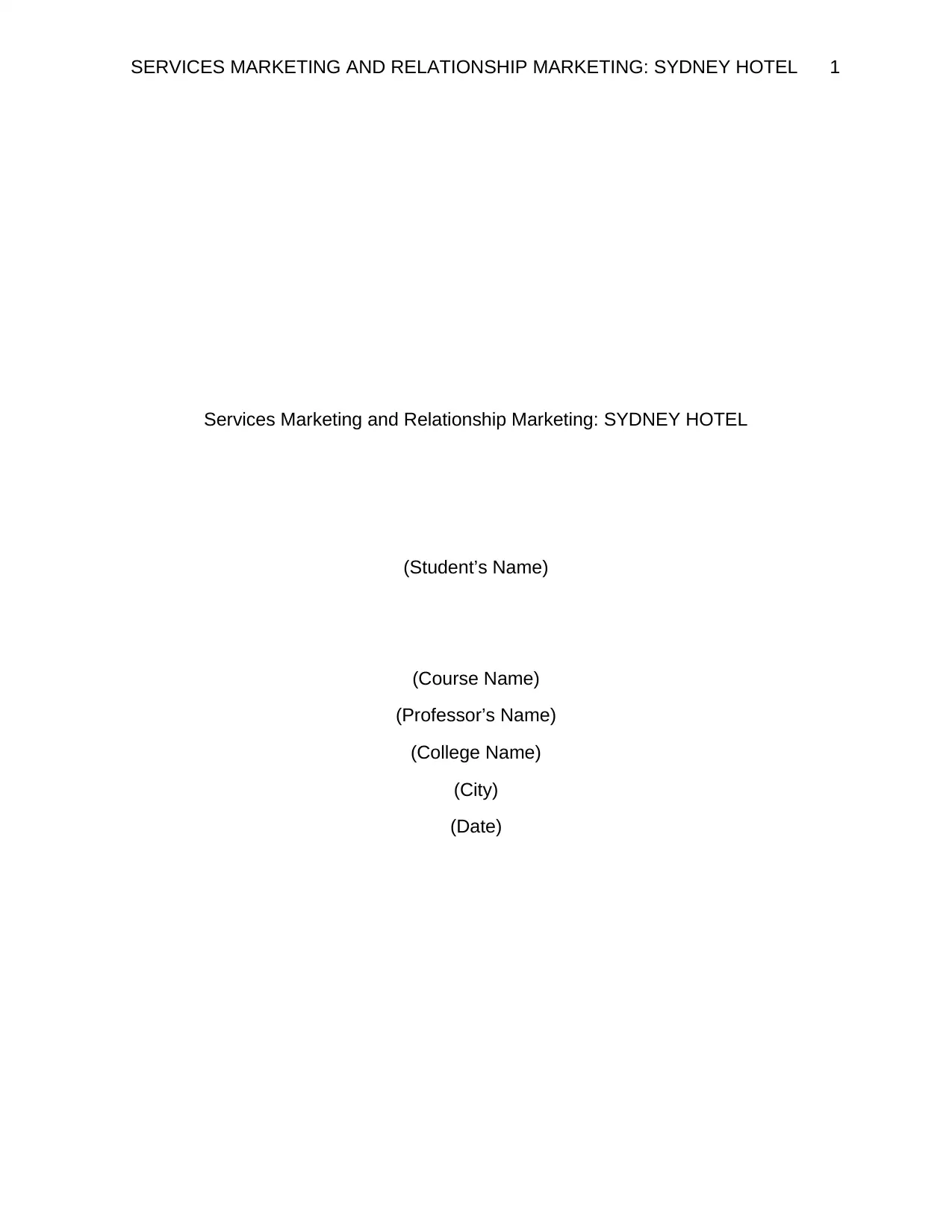
SERVICES MARKETING AND RELATIONSHIP MARKETING: SYDNEY HOTEL 1
Services Marketing and Relationship Marketing: SYDNEY HOTEL
(Student’s Name)
(Course Name)
(Professor’s Name)
(College Name)
(City)
(Date)
Services Marketing and Relationship Marketing: SYDNEY HOTEL
(Student’s Name)
(Course Name)
(Professor’s Name)
(College Name)
(City)
(Date)
Secure Best Marks with AI Grader
Need help grading? Try our AI Grader for instant feedback on your assignments.
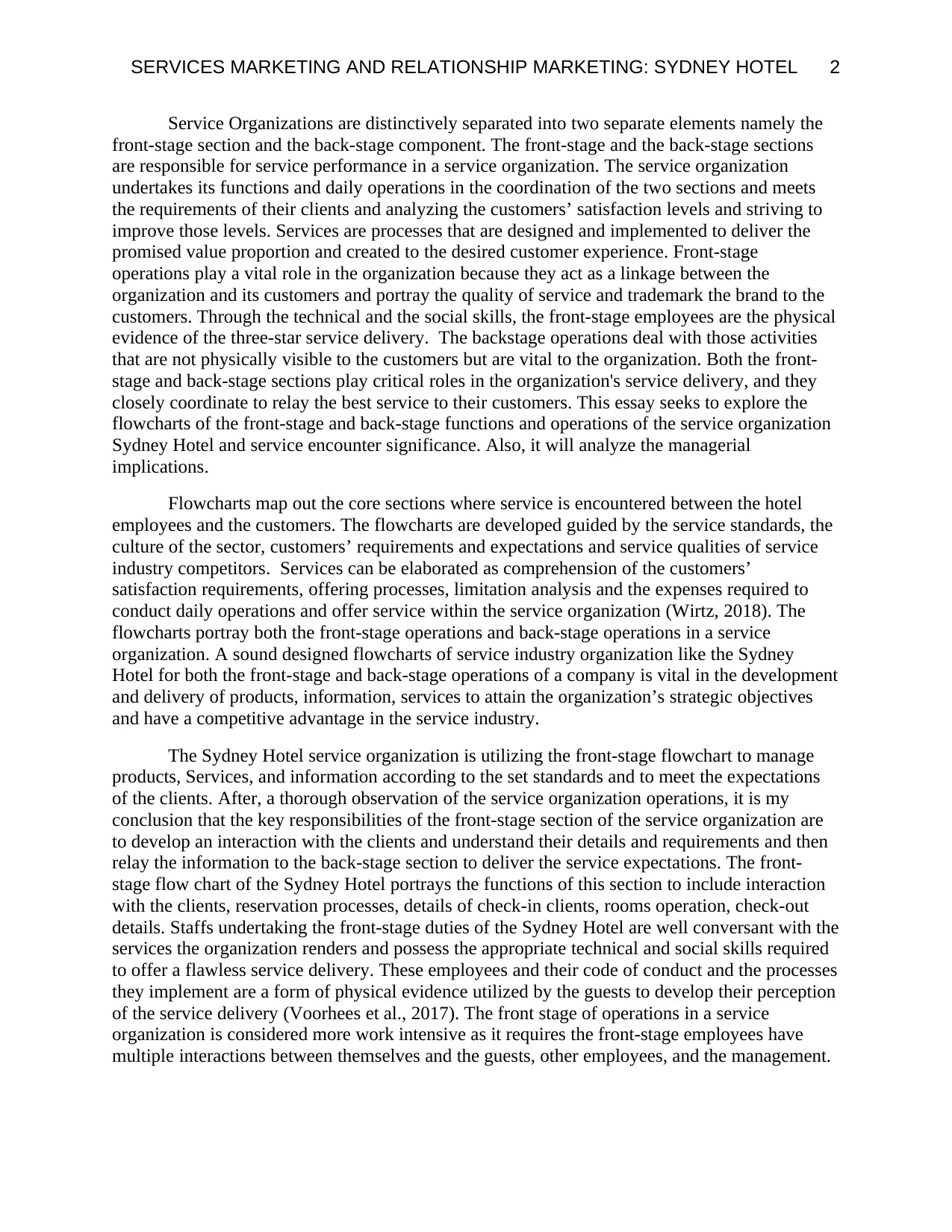
SERVICES MARKETING AND RELATIONSHIP MARKETING: SYDNEY HOTEL 2
Service Organizations are distinctively separated into two separate elements namely the
front-stage section and the back-stage component. The front-stage and the back-stage sections
are responsible for service performance in a service organization. The service organization
undertakes its functions and daily operations in the coordination of the two sections and meets
the requirements of their clients and analyzing the customers’ satisfaction levels and striving to
improve those levels. Services are processes that are designed and implemented to deliver the
promised value proportion and created to the desired customer experience. Front-stage
operations play a vital role in the organization because they act as a linkage between the
organization and its customers and portray the quality of service and trademark the brand to the
customers. Through the technical and the social skills, the front-stage employees are the physical
evidence of the three-star service delivery. The backstage operations deal with those activities
that are not physically visible to the customers but are vital to the organization. Both the front-
stage and back-stage sections play critical roles in the organization's service delivery, and they
closely coordinate to relay the best service to their customers. This essay seeks to explore the
flowcharts of the front-stage and back-stage functions and operations of the service organization
Sydney Hotel and service encounter significance. Also, it will analyze the managerial
implications.
Flowcharts map out the core sections where service is encountered between the hotel
employees and the customers. The flowcharts are developed guided by the service standards, the
culture of the sector, customers’ requirements and expectations and service qualities of service
industry competitors. Services can be elaborated as comprehension of the customers’
satisfaction requirements, offering processes, limitation analysis and the expenses required to
conduct daily operations and offer service within the service organization (Wirtz, 2018). The
flowcharts portray both the front-stage operations and back-stage operations in a service
organization. A sound designed flowcharts of service industry organization like the Sydney
Hotel for both the front-stage and back-stage operations of a company is vital in the development
and delivery of products, information, services to attain the organization’s strategic objectives
and have a competitive advantage in the service industry.
The Sydney Hotel service organization is utilizing the front-stage flowchart to manage
products, Services, and information according to the set standards and to meet the expectations
of the clients. After, a thorough observation of the service organization operations, it is my
conclusion that the key responsibilities of the front-stage section of the service organization are
to develop an interaction with the clients and understand their details and requirements and then
relay the information to the back-stage section to deliver the service expectations. The front-
stage flow chart of the Sydney Hotel portrays the functions of this section to include interaction
with the clients, reservation processes, details of check-in clients, rooms operation, check-out
details. Staffs undertaking the front-stage duties of the Sydney Hotel are well conversant with the
services the organization renders and possess the appropriate technical and social skills required
to offer a flawless service delivery. These employees and their code of conduct and the processes
they implement are a form of physical evidence utilized by the guests to develop their perception
of the service delivery (Voorhees et al., 2017). The front stage of operations in a service
organization is considered more work intensive as it requires the front-stage employees have
multiple interactions between themselves and the guests, other employees, and the management.
Service Organizations are distinctively separated into two separate elements namely the
front-stage section and the back-stage component. The front-stage and the back-stage sections
are responsible for service performance in a service organization. The service organization
undertakes its functions and daily operations in the coordination of the two sections and meets
the requirements of their clients and analyzing the customers’ satisfaction levels and striving to
improve those levels. Services are processes that are designed and implemented to deliver the
promised value proportion and created to the desired customer experience. Front-stage
operations play a vital role in the organization because they act as a linkage between the
organization and its customers and portray the quality of service and trademark the brand to the
customers. Through the technical and the social skills, the front-stage employees are the physical
evidence of the three-star service delivery. The backstage operations deal with those activities
that are not physically visible to the customers but are vital to the organization. Both the front-
stage and back-stage sections play critical roles in the organization's service delivery, and they
closely coordinate to relay the best service to their customers. This essay seeks to explore the
flowcharts of the front-stage and back-stage functions and operations of the service organization
Sydney Hotel and service encounter significance. Also, it will analyze the managerial
implications.
Flowcharts map out the core sections where service is encountered between the hotel
employees and the customers. The flowcharts are developed guided by the service standards, the
culture of the sector, customers’ requirements and expectations and service qualities of service
industry competitors. Services can be elaborated as comprehension of the customers’
satisfaction requirements, offering processes, limitation analysis and the expenses required to
conduct daily operations and offer service within the service organization (Wirtz, 2018). The
flowcharts portray both the front-stage operations and back-stage operations in a service
organization. A sound designed flowcharts of service industry organization like the Sydney
Hotel for both the front-stage and back-stage operations of a company is vital in the development
and delivery of products, information, services to attain the organization’s strategic objectives
and have a competitive advantage in the service industry.
The Sydney Hotel service organization is utilizing the front-stage flowchart to manage
products, Services, and information according to the set standards and to meet the expectations
of the clients. After, a thorough observation of the service organization operations, it is my
conclusion that the key responsibilities of the front-stage section of the service organization are
to develop an interaction with the clients and understand their details and requirements and then
relay the information to the back-stage section to deliver the service expectations. The front-
stage flow chart of the Sydney Hotel portrays the functions of this section to include interaction
with the clients, reservation processes, details of check-in clients, rooms operation, check-out
details. Staffs undertaking the front-stage duties of the Sydney Hotel are well conversant with the
services the organization renders and possess the appropriate technical and social skills required
to offer a flawless service delivery. These employees and their code of conduct and the processes
they implement are a form of physical evidence utilized by the guests to develop their perception
of the service delivery (Voorhees et al., 2017). The front stage of operations in a service
organization is considered more work intensive as it requires the front-stage employees have
multiple interactions between themselves and the guests, other employees, and the management.
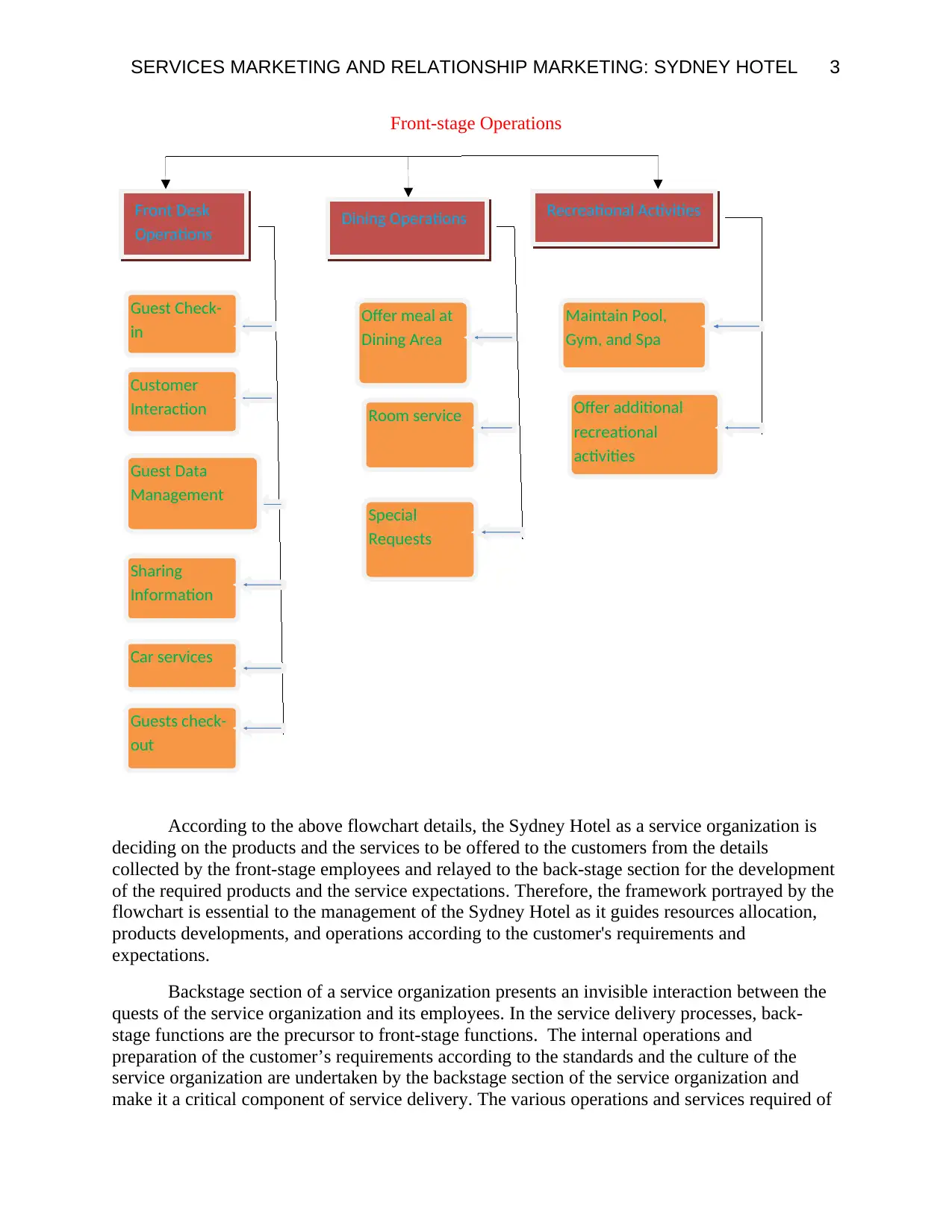
SERVICES MARKETING AND RELATIONSHIP MARKETING: SYDNEY HOTEL 3
Front-stage Operations
According to the above flowchart details, the Sydney Hotel as a service organization is
deciding on the products and the services to be offered to the customers from the details
collected by the front-stage employees and relayed to the back-stage section for the development
of the required products and the service expectations. Therefore, the framework portrayed by the
flowchart is essential to the management of the Sydney Hotel as it guides resources allocation,
products developments, and operations according to the customer's requirements and
expectations.
Backstage section of a service organization presents an invisible interaction between the
quests of the service organization and its employees. In the service delivery processes, back-
stage functions are the precursor to front-stage functions. The internal operations and
preparation of the customer’s requirements according to the standards and the culture of the
service organization are undertaken by the backstage section of the service organization and
make it a critical component of service delivery. The various operations and services required of
Recreational Activities
Guest Check-
in
Front Desk
Operations Dining Operations
Customer
Interaction
Guest Data
Management
Car services
Guests check-
out
Sharing
Information
Special
Requests
Room service
Offer meal at
Dining Area
Offer additional
recreational
activities
Maintain Pool,
Gym, and Spa
Front-stage Operations
According to the above flowchart details, the Sydney Hotel as a service organization is
deciding on the products and the services to be offered to the customers from the details
collected by the front-stage employees and relayed to the back-stage section for the development
of the required products and the service expectations. Therefore, the framework portrayed by the
flowchart is essential to the management of the Sydney Hotel as it guides resources allocation,
products developments, and operations according to the customer's requirements and
expectations.
Backstage section of a service organization presents an invisible interaction between the
quests of the service organization and its employees. In the service delivery processes, back-
stage functions are the precursor to front-stage functions. The internal operations and
preparation of the customer’s requirements according to the standards and the culture of the
service organization are undertaken by the backstage section of the service organization and
make it a critical component of service delivery. The various operations and services required of
Recreational Activities
Guest Check-
in
Front Desk
Operations Dining Operations
Customer
Interaction
Guest Data
Management
Car services
Guests check-
out
Sharing
Information
Special
Requests
Room service
Offer meal at
Dining Area
Offer additional
recreational
activities
Maintain Pool,
Gym, and Spa
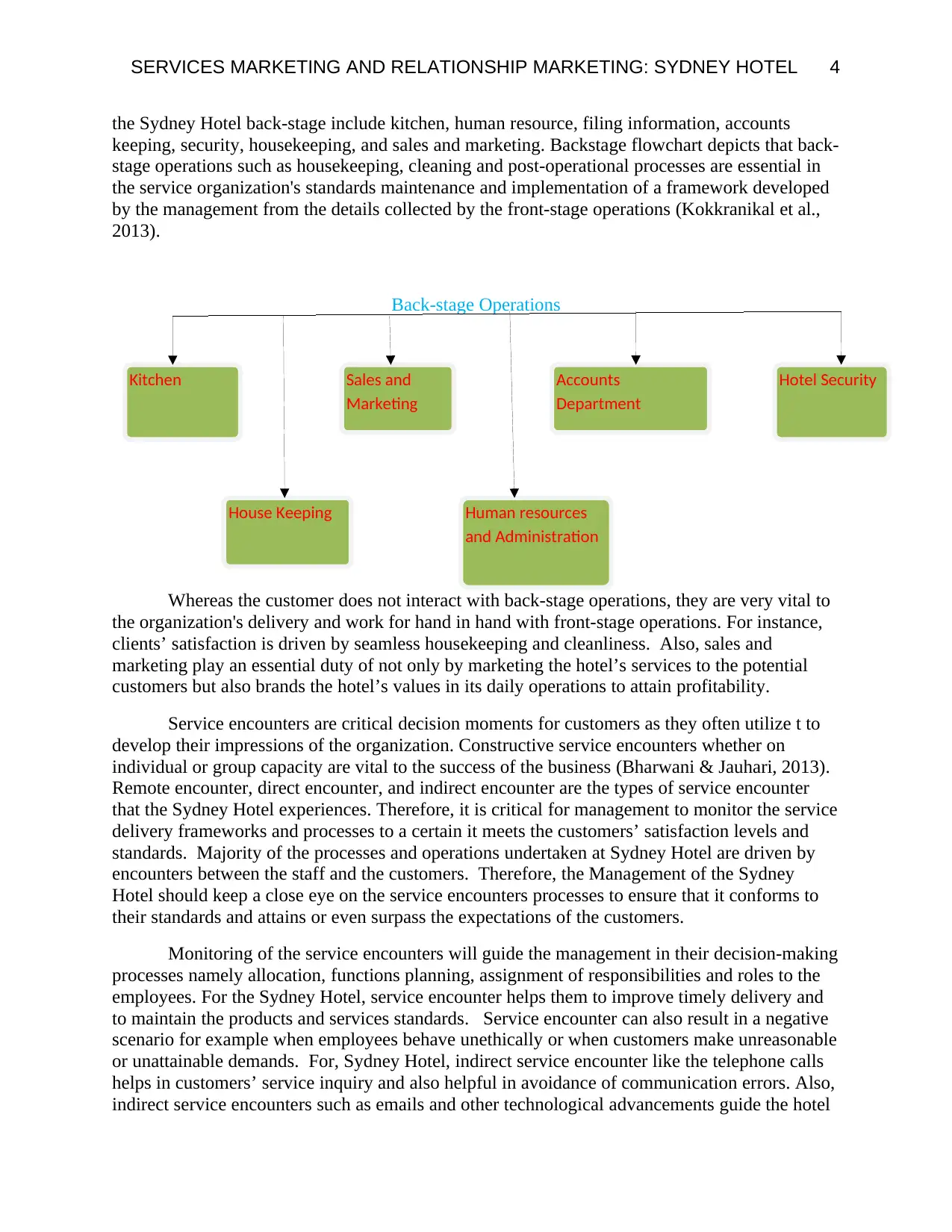
SERVICES MARKETING AND RELATIONSHIP MARKETING: SYDNEY HOTEL 4
the Sydney Hotel back-stage include kitchen, human resource, filing information, accounts
keeping, security, housekeeping, and sales and marketing. Backstage flowchart depicts that back-
stage operations such as housekeeping, cleaning and post-operational processes are essential in
the service organization's standards maintenance and implementation of a framework developed
by the management from the details collected by the front-stage operations (Kokkranikal et al.,
2013).
Back-stage Operations
Whereas the customer does not interact with back-stage operations, they are very vital to
the organization's delivery and work for hand in hand with front-stage operations. For instance,
clients’ satisfaction is driven by seamless housekeeping and cleanliness. Also, sales and
marketing play an essential duty of not only by marketing the hotel’s services to the potential
customers but also brands the hotel’s values in its daily operations to attain profitability.
Service encounters are critical decision moments for customers as they often utilize t to
develop their impressions of the organization. Constructive service encounters whether on
individual or group capacity are vital to the success of the business (Bharwani & Jauhari, 2013).
Remote encounter, direct encounter, and indirect encounter are the types of service encounter
that the Sydney Hotel experiences. Therefore, it is critical for management to monitor the service
delivery frameworks and processes to a certain it meets the customers’ satisfaction levels and
standards. Majority of the processes and operations undertaken at Sydney Hotel are driven by
encounters between the staff and the customers. Therefore, the Management of the Sydney
Hotel should keep a close eye on the service encounters processes to ensure that it conforms to
their standards and attains or even surpass the expectations of the customers.
Monitoring of the service encounters will guide the management in their decision-making
processes namely allocation, functions planning, assignment of responsibilities and roles to the
employees. For the Sydney Hotel, service encounter helps them to improve timely delivery and
to maintain the products and services standards. Service encounter can also result in a negative
scenario for example when employees behave unethically or when customers make unreasonable
or unattainable demands. For, Sydney Hotel, indirect service encounter like the telephone calls
helps in customers’ service inquiry and also helpful in avoidance of communication errors. Also,
indirect service encounters such as emails and other technological advancements guide the hotel
Kitchen Sales and
Marketing
Accounts
Department
Hotel Security
House Keeping Human resources
and Administration
the Sydney Hotel back-stage include kitchen, human resource, filing information, accounts
keeping, security, housekeeping, and sales and marketing. Backstage flowchart depicts that back-
stage operations such as housekeeping, cleaning and post-operational processes are essential in
the service organization's standards maintenance and implementation of a framework developed
by the management from the details collected by the front-stage operations (Kokkranikal et al.,
2013).
Back-stage Operations
Whereas the customer does not interact with back-stage operations, they are very vital to
the organization's delivery and work for hand in hand with front-stage operations. For instance,
clients’ satisfaction is driven by seamless housekeeping and cleanliness. Also, sales and
marketing play an essential duty of not only by marketing the hotel’s services to the potential
customers but also brands the hotel’s values in its daily operations to attain profitability.
Service encounters are critical decision moments for customers as they often utilize t to
develop their impressions of the organization. Constructive service encounters whether on
individual or group capacity are vital to the success of the business (Bharwani & Jauhari, 2013).
Remote encounter, direct encounter, and indirect encounter are the types of service encounter
that the Sydney Hotel experiences. Therefore, it is critical for management to monitor the service
delivery frameworks and processes to a certain it meets the customers’ satisfaction levels and
standards. Majority of the processes and operations undertaken at Sydney Hotel are driven by
encounters between the staff and the customers. Therefore, the Management of the Sydney
Hotel should keep a close eye on the service encounters processes to ensure that it conforms to
their standards and attains or even surpass the expectations of the customers.
Monitoring of the service encounters will guide the management in their decision-making
processes namely allocation, functions planning, assignment of responsibilities and roles to the
employees. For the Sydney Hotel, service encounter helps them to improve timely delivery and
to maintain the products and services standards. Service encounter can also result in a negative
scenario for example when employees behave unethically or when customers make unreasonable
or unattainable demands. For, Sydney Hotel, indirect service encounter like the telephone calls
helps in customers’ service inquiry and also helpful in avoidance of communication errors. Also,
indirect service encounters such as emails and other technological advancements guide the hotel
Kitchen Sales and
Marketing
Accounts
Department
Hotel Security
House Keeping Human resources
and Administration
Secure Best Marks with AI Grader
Need help grading? Try our AI Grader for instant feedback on your assignments.
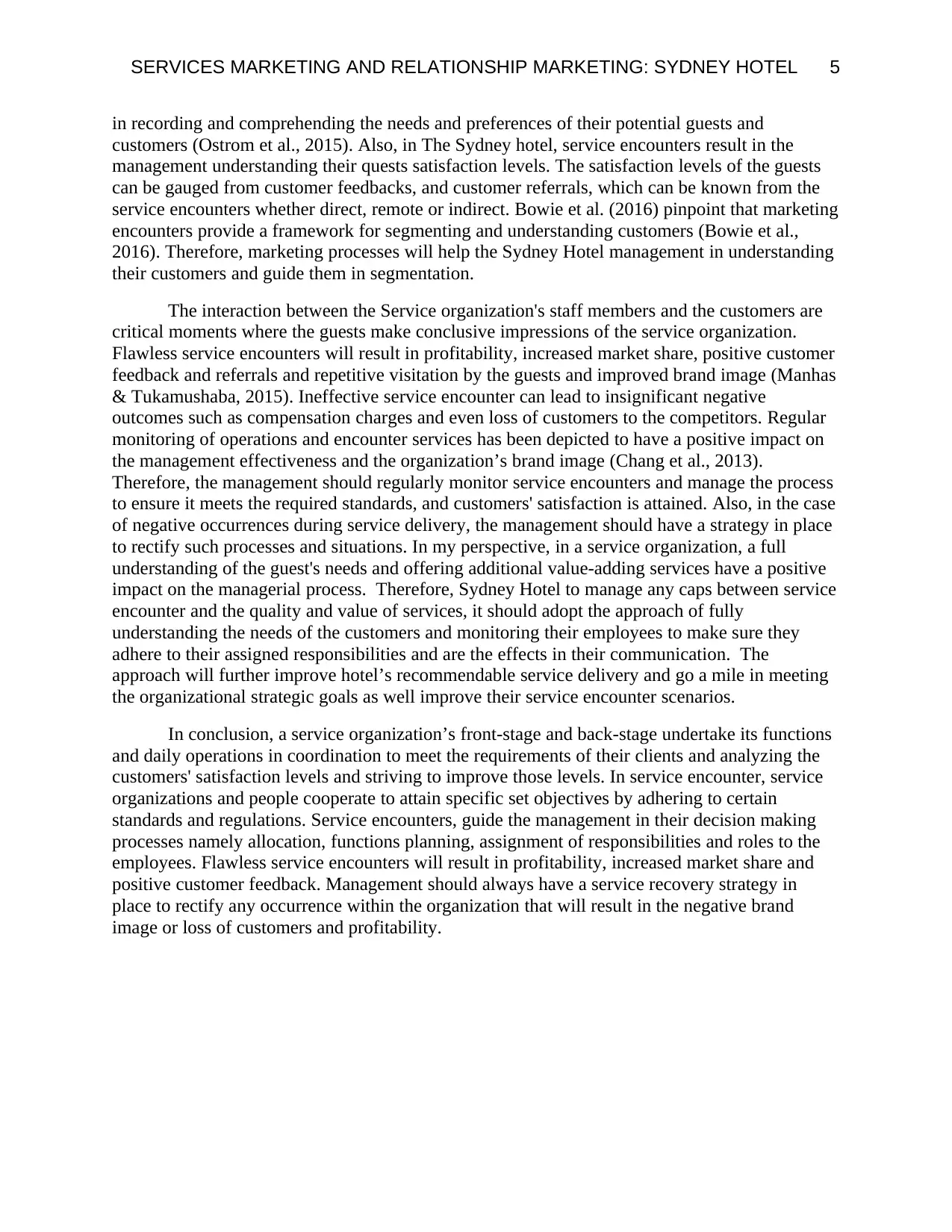
SERVICES MARKETING AND RELATIONSHIP MARKETING: SYDNEY HOTEL 5
in recording and comprehending the needs and preferences of their potential guests and
customers (Ostrom et al., 2015). Also, in The Sydney hotel, service encounters result in the
management understanding their quests satisfaction levels. The satisfaction levels of the guests
can be gauged from customer feedbacks, and customer referrals, which can be known from the
service encounters whether direct, remote or indirect. Bowie et al. (2016) pinpoint that marketing
encounters provide a framework for segmenting and understanding customers (Bowie et al.,
2016). Therefore, marketing processes will help the Sydney Hotel management in understanding
their customers and guide them in segmentation.
The interaction between the Service organization's staff members and the customers are
critical moments where the guests make conclusive impressions of the service organization.
Flawless service encounters will result in profitability, increased market share, positive customer
feedback and referrals and repetitive visitation by the guests and improved brand image (Manhas
& Tukamushaba, 2015). Ineffective service encounter can lead to insignificant negative
outcomes such as compensation charges and even loss of customers to the competitors. Regular
monitoring of operations and encounter services has been depicted to have a positive impact on
the management effectiveness and the organization’s brand image (Chang et al., 2013).
Therefore, the management should regularly monitor service encounters and manage the process
to ensure it meets the required standards, and customers' satisfaction is attained. Also, in the case
of negative occurrences during service delivery, the management should have a strategy in place
to rectify such processes and situations. In my perspective, in a service organization, a full
understanding of the guest's needs and offering additional value-adding services have a positive
impact on the managerial process. Therefore, Sydney Hotel to manage any caps between service
encounter and the quality and value of services, it should adopt the approach of fully
understanding the needs of the customers and monitoring their employees to make sure they
adhere to their assigned responsibilities and are the effects in their communication. The
approach will further improve hotel’s recommendable service delivery and go a mile in meeting
the organizational strategic goals as well improve their service encounter scenarios.
In conclusion, a service organization’s front-stage and back-stage undertake its functions
and daily operations in coordination to meet the requirements of their clients and analyzing the
customers' satisfaction levels and striving to improve those levels. In service encounter, service
organizations and people cooperate to attain specific set objectives by adhering to certain
standards and regulations. Service encounters, guide the management in their decision making
processes namely allocation, functions planning, assignment of responsibilities and roles to the
employees. Flawless service encounters will result in profitability, increased market share and
positive customer feedback. Management should always have a service recovery strategy in
place to rectify any occurrence within the organization that will result in the negative brand
image or loss of customers and profitability.
in recording and comprehending the needs and preferences of their potential guests and
customers (Ostrom et al., 2015). Also, in The Sydney hotel, service encounters result in the
management understanding their quests satisfaction levels. The satisfaction levels of the guests
can be gauged from customer feedbacks, and customer referrals, which can be known from the
service encounters whether direct, remote or indirect. Bowie et al. (2016) pinpoint that marketing
encounters provide a framework for segmenting and understanding customers (Bowie et al.,
2016). Therefore, marketing processes will help the Sydney Hotel management in understanding
their customers and guide them in segmentation.
The interaction between the Service organization's staff members and the customers are
critical moments where the guests make conclusive impressions of the service organization.
Flawless service encounters will result in profitability, increased market share, positive customer
feedback and referrals and repetitive visitation by the guests and improved brand image (Manhas
& Tukamushaba, 2015). Ineffective service encounter can lead to insignificant negative
outcomes such as compensation charges and even loss of customers to the competitors. Regular
monitoring of operations and encounter services has been depicted to have a positive impact on
the management effectiveness and the organization’s brand image (Chang et al., 2013).
Therefore, the management should regularly monitor service encounters and manage the process
to ensure it meets the required standards, and customers' satisfaction is attained. Also, in the case
of negative occurrences during service delivery, the management should have a strategy in place
to rectify such processes and situations. In my perspective, in a service organization, a full
understanding of the guest's needs and offering additional value-adding services have a positive
impact on the managerial process. Therefore, Sydney Hotel to manage any caps between service
encounter and the quality and value of services, it should adopt the approach of fully
understanding the needs of the customers and monitoring their employees to make sure they
adhere to their assigned responsibilities and are the effects in their communication. The
approach will further improve hotel’s recommendable service delivery and go a mile in meeting
the organizational strategic goals as well improve their service encounter scenarios.
In conclusion, a service organization’s front-stage and back-stage undertake its functions
and daily operations in coordination to meet the requirements of their clients and analyzing the
customers' satisfaction levels and striving to improve those levels. In service encounter, service
organizations and people cooperate to attain specific set objectives by adhering to certain
standards and regulations. Service encounters, guide the management in their decision making
processes namely allocation, functions planning, assignment of responsibilities and roles to the
employees. Flawless service encounters will result in profitability, increased market share and
positive customer feedback. Management should always have a service recovery strategy in
place to rectify any occurrence within the organization that will result in the negative brand
image or loss of customers and profitability.
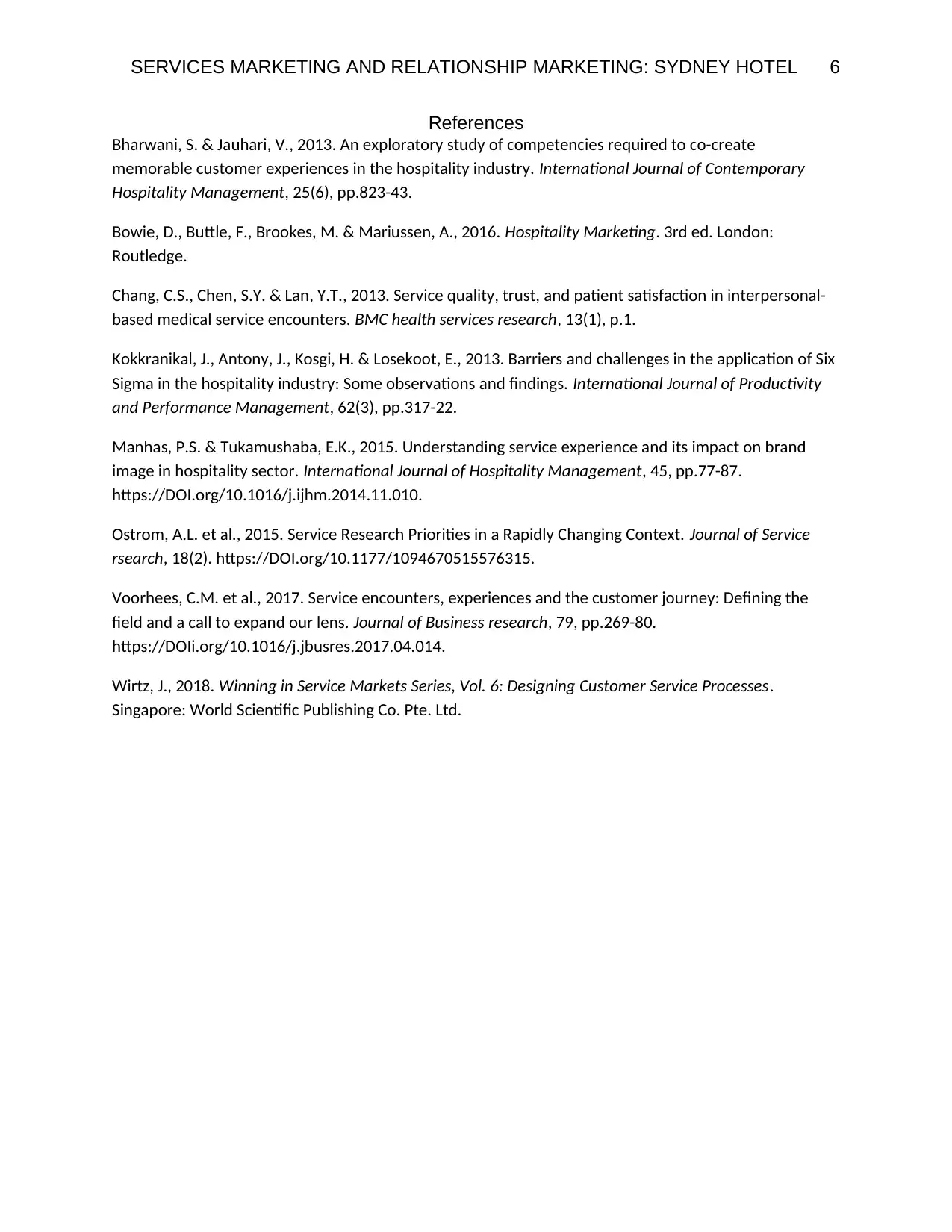
SERVICES MARKETING AND RELATIONSHIP MARKETING: SYDNEY HOTEL 6
References
Bharwani, S. & Jauhari, V., 2013. An exploratory study of competencies required to co-create
memorable customer experiences in the hospitality industry. International Journal of Contemporary
Hospitality Management, 25(6), pp.823-43.
Bowie, D., Buttle, F., Brookes, M. & Mariussen, A., 2016. Hospitality Marketing. 3rd ed. London:
Routledge.
Chang, C.S., Chen, S.Y. & Lan, Y.T., 2013. Service quality, trust, and patient satisfaction in interpersonal-
based medical service encounters. BMC health services research, 13(1), p.1.
Kokkranikal, J., Antony, J., Kosgi, H. & Losekoot, E., 2013. Barriers and challenges in the application of Six
Sigma in the hospitality industry: Some observations and findings. International Journal of Productivity
and Performance Management, 62(3), pp.317-22.
Manhas, P.S. & Tukamushaba, E.K., 2015. Understanding service experience and its impact on brand
image in hospitality sector. International Journal of Hospitality Management, 45, pp.77-87.
https://DOI.org/10.1016/j.ijhm.2014.11.010.
Ostrom, A.L. et al., 2015. Service Research Priorities in a Rapidly Changing Context. Journal of Service
rsearch, 18(2). https://DOI.org/10.1177/1094670515576315.
Voorhees, C.M. et al., 2017. Service encounters, experiences and the customer journey: Defining the
field and a call to expand our lens. Journal of Business research, 79, pp.269-80.
https://DOIi.org/10.1016/j.jbusres.2017.04.014.
Wirtz, J., 2018. Winning in Service Markets Series, Vol. 6: Designing Customer Service Processes.
Singapore: World Scientific Publishing Co. Pte. Ltd.
References
Bharwani, S. & Jauhari, V., 2013. An exploratory study of competencies required to co-create
memorable customer experiences in the hospitality industry. International Journal of Contemporary
Hospitality Management, 25(6), pp.823-43.
Bowie, D., Buttle, F., Brookes, M. & Mariussen, A., 2016. Hospitality Marketing. 3rd ed. London:
Routledge.
Chang, C.S., Chen, S.Y. & Lan, Y.T., 2013. Service quality, trust, and patient satisfaction in interpersonal-
based medical service encounters. BMC health services research, 13(1), p.1.
Kokkranikal, J., Antony, J., Kosgi, H. & Losekoot, E., 2013. Barriers and challenges in the application of Six
Sigma in the hospitality industry: Some observations and findings. International Journal of Productivity
and Performance Management, 62(3), pp.317-22.
Manhas, P.S. & Tukamushaba, E.K., 2015. Understanding service experience and its impact on brand
image in hospitality sector. International Journal of Hospitality Management, 45, pp.77-87.
https://DOI.org/10.1016/j.ijhm.2014.11.010.
Ostrom, A.L. et al., 2015. Service Research Priorities in a Rapidly Changing Context. Journal of Service
rsearch, 18(2). https://DOI.org/10.1177/1094670515576315.
Voorhees, C.M. et al., 2017. Service encounters, experiences and the customer journey: Defining the
field and a call to expand our lens. Journal of Business research, 79, pp.269-80.
https://DOIi.org/10.1016/j.jbusres.2017.04.014.
Wirtz, J., 2018. Winning in Service Markets Series, Vol. 6: Designing Customer Service Processes.
Singapore: World Scientific Publishing Co. Pte. Ltd.
1 out of 6
Related Documents
Your All-in-One AI-Powered Toolkit for Academic Success.
+13062052269
info@desklib.com
Available 24*7 on WhatsApp / Email
![[object Object]](/_next/static/media/star-bottom.7253800d.svg)
Unlock your academic potential
© 2024 | Zucol Services PVT LTD | All rights reserved.





